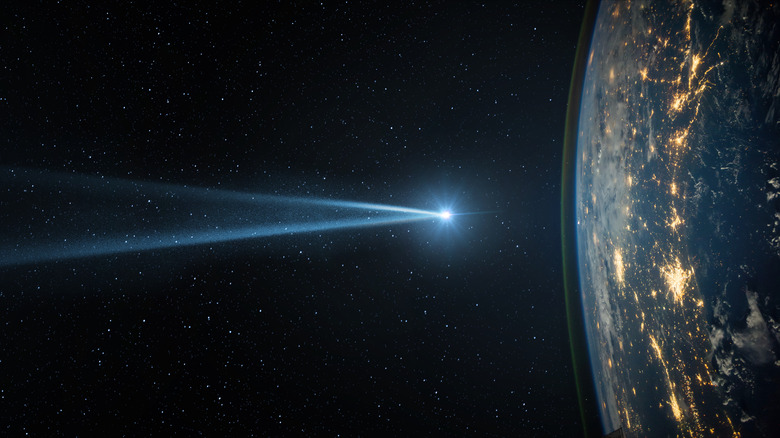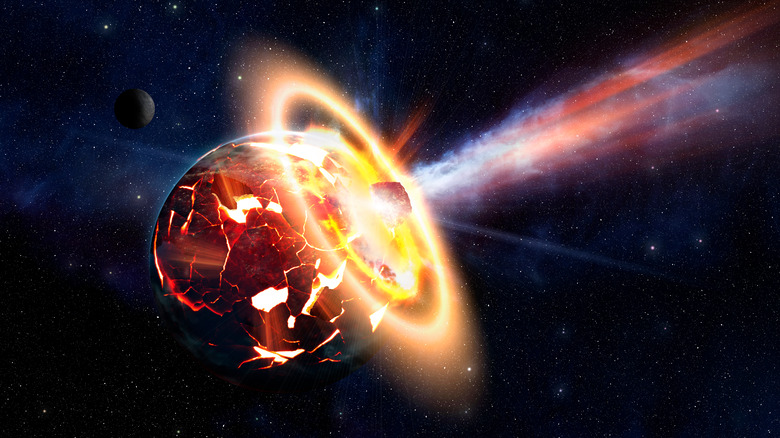How Large An Asteroid Must Be To Destroy The Earth
So many of us struggle with the notion of just how large our beloved planet Earth really is. For some sense of its scale, here's a statistic from How Stuff Works: The mass of the Earth is estimated at 6,000,000,000,000,000,000,000,000 kilograms. The math involved is almost entirely incomprehensible in itself, without taking into account the fact that we're all living on a rock in space that is of that kind of impossible scale.
In terms of the wider expanses of space, though, our planet isn't even particularly large. In January 2020, for instance, NASA announced that a planet had been located by Wolf Cukier, a student who had been interning at Maryland's Goddard Space Flight Center. This new planet, designated TOI 1338, is almost seven times bigger than Earth, slotting in nicely on the scale between Neptune and Saturn.
In our solar system and outside of it, Earth isn't particularly impressive in terms of size. It is also subject to a wide array of natural disasters. With these two factors in mind, then, you might wonder how devastating an asteroid or meteor strike could be. As it turns out, it would take a truly hefty body to destroy the planet.
A surprising number of small-fry asteroids hit the Earth
As much as humanity may like to think that they're the center of the universe, there are innumerable other planets and astrological bodies out there. Ultimately, Earth is quite a small target for asteroids careening around, but collisions can and have happened. Per The Harvard Gazette, the most famous of these was the Chicxulub impactor, the asteroid that devastated the dinosaurs (and much of the rest of life on the planet at the time) in a calamitous impact that resulted in a crater 93 miles wide.
The key thing to note here, though, is that refrigerator magnets, smartphones, Cheetos and other familiar Earthen luxuries are still here to be enjoyed millions of years later, so it's safe to say that this impact did not destroy the planet, as monumental as it was.
Indeed, the Earth is subject to alarmingly regular attention from asteroids. NASA Science reports that, in the two decades between 1994 and 2013, 556 different asteroids entered the planet's atmosphere. Fortunately, said atmosphere is no friend to them, and they reportedly break up, ranging from as large as 60 feet to as small as three feet. It would take something much larger than that to truly imperil the Earth.
It's not easy to wipe out all life on Earth, thankfully
Naturally, the damage an asteroid could potentially inflict is heavily impacted by its side. According to the University of Colorado Boulder's Brian Toon (via Futurism), a collision from an asteroid around half-a-mile (eight-tenths of a kilometer) in size would be enough to generate energy equal to an absurd amount of TNT: 100 billion tons of it.
Any such strike would be tragic and profoundly impactful, but according to Futurism, it's believed that only an asteroid of around 60 miles would be potent enough to truly end all life on Earth.
It's a harrowing thought, but some of the world's finest minds are exploring various ways to protect the planet from such threats, now and in the future. As CBS News reported, for instance, NASA and SpaceX launched a Double Asteroid Redirection Test in December of 2021. A small unmanned probe was launched towards a huge, distant asteroid (the journey will take almost a year) known as Dimorphos. This planet isn't a danger, but the pioneering experiment is a test to see whether pushing big threats away from Earth is a viable option. The results could help shape our future.


